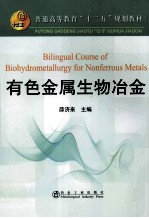
- 作 者:薛济来主编
- 出 版 社:北京:冶金工业出版社
- 出版年份:2012
- ISBN:9787502461539
- 标注页数:123 页
- PDF页数:134 页
请阅读订购服务说明与试读!
订购服务说明
1、本站所有的书默认都是PDF格式,该格式图书只能阅读和打印,不能再次编辑。
2、除分上下册或者多册的情况下,一般PDF页数一定要大于标注页数才建议下单购买。【本资源134 ≥123页】
图书下载及付费说明
1、所有的电子图书为PDF格式,支持电脑、手机、平板等各类电子设备阅读;可以任意拷贝文件到不同的阅读设备里进行阅读。
2、电子图书在提交订单后一般半小时内处理完成,最晚48小时内处理完成。(非工作日购买会延迟)
3、所有的电子图书都是原书直接扫描方式制作而成。
1 Biohydrometallurgy and Bacteria 1
1.1 Introduction 1
1.2 Development in Hydrometallurgy 2
1.3 Bacteria and Phylogeny 4
1.4 Nutrition 7
1.4.1 Carbon nutrition sources 7
1.4.2 Nitrogen nutrition sources 7
1.5 Energy Sources 8
1.5.1 Iron oxidation 8
1.5.2 Sulfur oxidation 9
1.5.3 Electron donors and electron acceptors 10
1.5.4 Mineral oxidating ability 11
1.6 Mesophilic and Acidophiles in Mineral Bioleaching 12
1.7 Summary 15
Questions 15
Note 15
2 Surface Chemistry of Bacterial Leaching 17
2.1 Introduction 17
2.2 Adhesion and Attachment of Bacteria to Mineral Surfaces 18
2.3 Theory of Bacterial Attachment to Surfaces 20
2.4 Biofilm Colloid Formation on Bacterial Cells 26
2.5 Summary 27
Questions 27
Note 27
3 Electrochemistry of Mineral Dissolution and Bioleaching 29
3.1 Introduction 29
3.2 Electrochemical Mechanism of Oxidative and Reductive Reactions 30
3.2.1 Anodic and cathodic reactions 30
3.2.2 Influence of the electronic structure of the mineral on the dissolution rate 31
3.3 Applications of Electrochemical Mechanism in Leaching 32
3.3.1 Chemical leaching of pyrite by ferric ions 32
3.3.2 Effect of bacterial action on the mixed potential of pyrite 33
3.3.3 Effect of electrochemical bioleaching on the copper recovery 35
3.4 Electrochemical Kinetics and Modeling 35
3.4.1 Kinetics of the oxidative dissolution of sphalerite 35
3.4.2 Electrochemical kinetics and model of bacterial leaching 37
3.5 Summary 39
Questions 39
Note 40
4 Biohydrometallurgy of Copper 41
4.1 Introduction 41
4.2 Definitions and Mineralogy Related to Copper Leaching 41
4.2.1 Pyrite 42
4.2.2 Secondary sulfides 42
4.2.3 Primary sulfides 43
4.3 Physico-Chemical Leaching Variables 43
4.3.1 Surface area 43
4.3.2 Acid levels 44
4.3.3 Oxidants 44
4.3.4 Agglomeration 44
4.3.5 Curing time 45
4.3.6 Permeability 45
4.4 Bacterial Leaching Variables 45
4.4.1 Acidity 45
4.4.2 Oxygen 46
4.4.3 Nutrition 46
4.4.4 Heat 47
4.4.5 Mineralogy 47
4.4.6 Bacterial inoculation 47
4.4.7 Iron 48
4.5 Heap Operating Variables 48
4.5.1 Irrigation distribution 48
4.5.2 Solution stacking 49
4.5.3 Solution collection 49
4.5.4 Pad stacking/configuration 50
4.6 Leach Solution Processing 50
4.6.1 Copper cementation 51
4.6.2 Direct electrowinning 51
4.6.3 Solvent extraction 51
4.6.4 Electrowinning 53
4.7 Commercial Installations and Environmental Considerations 54
4.7.1 In situ leaching 55
4.7.2 Dump leaching 56
4.7.3 Heap leaching 56
4.8 Summary 58
Questions 58
Note 58
5 Biooxidation of Gold-Bearing Ores 60
5.1 Introduction 60
5.2 BIOX? Bacterial Culture 61
5.3 Chemical Reactions and Process Control 63
5.3.1 Chemical reactions 63
5.3.2 Influence of ore mineralogy 64
5.3.3 Effect of temperature and cooling requirements 65
5.3.4 pH control 66
5.3.5 Oxygen supply 67
5.4 Operations Conditions and Process Requirements 68
5.4.1 Bioreactor configuration 68
5.4.2 Rate of sulfide mineral oxidation and gold dissolution 69
5.4.3 General process requirements 70
5.4.4 Effects of chloride and arsenic on BIOX? process 71
5.5 Summary 72
Questions 73
Note 73
6 Biohydrometallurgical Processing of Colt,Nickel and Zinc 74
6.1 Introduction 74
6.2 Cobalt Bioleaching with Autotrophic and Mixotrophic Bacteria 75
6.3 Nickel Bioleaching with Autotrophic and Mixotrophic Bacteria 77
6.4 Zinc Bioleaching with Autotrophic and Mixotrophic Bacteria 78
6.5 Metal Mobilization by Microbially Generated Acids/Ligands 80
6.6 Summary 84
Questions 84
Note 85
7 Biohydrometallurgical Recovery of Heavy Metals from Industrial Wastes 86
7.1 Introduction 86
7.2 Metal Recovery from Waste Sludge and Fly Ash 87
7.3 Metal Recovery from Mine Waste and Nuclear Waste 89
7.4 Metal Recovery from River Sediments and Metal Finishing Waste Water 92
7.5 Summary 94
Questions 94
Note 95
8 Biohydrometallurgical Recovery of Value Metals from Secondary Sources 96
8.1 Introduction 96
8.2 Metal Recovery from Electronic Wastes 96
8.3 Metal Recovery from Battery Wastes 100
8.4 Metal Recovery from Spent Petroleum Refinery Catalyst 103
8.5 Summary 105
Questions 106
Note 106
Appendix 107
References 122
